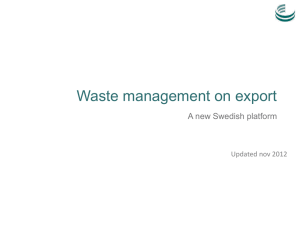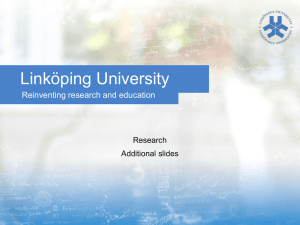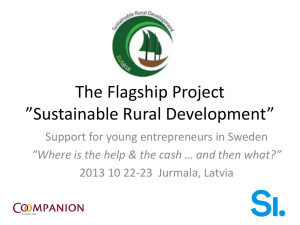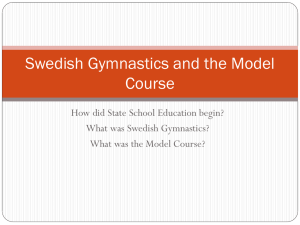Adding a constructicon to the Swedish resource network of
advertisement
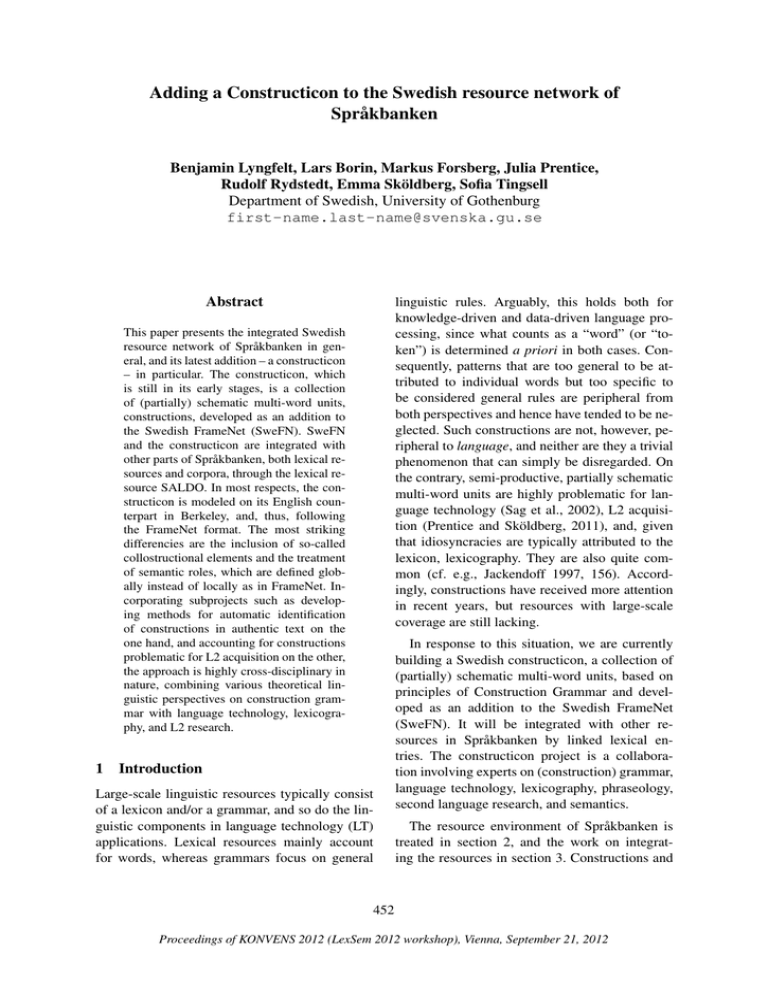
Adding a Constructicon to the Swedish resource network of Språkbanken Benjamin Lyngfelt, Lars Borin, Markus Forsberg, Julia Prentice, Rudolf Rydstedt, Emma Sköldberg, Sofia Tingsell Department of Swedish, University of Gothenburg first-name.last-name@svenska.gu.se Abstract linguistic rules. Arguably, this holds both for knowledge-driven and data-driven language processing, since what counts as a “word” (or “token”) is determined a priori in both cases. Consequently, patterns that are too general to be attributed to individual words but too specific to be considered general rules are peripheral from both perspectives and hence have tended to be neglected. Such constructions are not, however, peripheral to language, and neither are they a trivial phenomenon that can simply be disregarded. On the contrary, semi-productive, partially schematic multi-word units are highly problematic for language technology (Sag et al., 2002), L2 acquisition (Prentice and Sköldberg, 2011), and, given that idiosyncracies are typically attributed to the lexicon, lexicography. They are also quite common (cf. e.g., Jackendoff 1997, 156). Accordingly, constructions have received more attention in recent years, but resources with large-scale coverage are still lacking. This paper presents the integrated Swedish resource network of Språkbanken in general, and its latest addition – a constructicon – in particular. The constructicon, which is still in its early stages, is a collection of (partially) schematic multi-word units, constructions, developed as an addition to the Swedish FrameNet (SweFN). SweFN and the constructicon are integrated with other parts of Språkbanken, both lexical resources and corpora, through the lexical resource SALDO. In most respects, the constructicon is modeled on its English counterpart in Berkeley, and, thus, following the FrameNet format. The most striking differencies are the inclusion of so-called collostructional elements and the treatment of semantic roles, which are defined globally instead of locally as in FrameNet. Incorporating subprojects such as developing methods for automatic identification of constructions in authentic text on the one hand, and accounting for constructions problematic for L2 acquisition on the other, the approach is highly cross-disciplinary in nature, combining various theoretical linguistic perspectives on construction grammar with language technology, lexicography, and L2 research. 1 Introduction Large-scale linguistic resources typically consist of a lexicon and/or a grammar, and so do the linguistic components in language technology (LT) applications. Lexical resources mainly account for words, whereas grammars focus on general In response to this situation, we are currently building a Swedish constructicon, a collection of (partially) schematic multi-word units, based on principles of Construction Grammar and developed as an addition to the Swedish FrameNet (SweFN). It will be integrated with other resources in Språkbanken by linked lexical entries. The constructicon project is a collaboration involving experts on (construction) grammar, language technology, lexicography, phraseology, second language research, and semantics. The resource environment of Språkbanken is treated in section 2, and the work on integrating the resources in section 3. Constructions and 452 Proceedings of KONVENS 2012 (LexSem 2012 workshop), Vienna, September 21, 2012 Construction Grammar are introduced in section 4 and the Swedish constructicon is presented in section 5, followed by an outlook in section 6. 2 Språkbanken Språkbanken (the Swedish Language Bank)1 is a research and development unit at the University of Gothenburg, which was established with government funding already in 1975 as a national center for research on Swedish language resources, in particular corpora and lexical resources. The main focus of Språkbanken’s present-day activities is in the development and refinement of language resources and LT tools, and their application as research and teaching tools in various fields outside LT itself – several areas of linguistics: descriptive, typological, historical and genetic linguistics (e.g., Saxena and Borin 2011; Rama and Borin 2011), Swedish as a second language (e.g., Johansson Kokkinakis and Magnusson 2011; Volodina and Johansson Kokkinakis 2012), computerassisted language learning, text complexity and lexical semantics (e.g., Borin 2012); other humanities disciplines: comparative literature (e.g. Borin and Kokkinakis 2010; Oelke et al. 2012) and history (e.g. Borin et al. 2011); and medicine and medical informatics (e.g., Kokkinakis 2012; Heppin 2011) – i.e., activities that can be broadly characterized as LT-based eScience. Språkbanken’s LT research activities and inhouse LT tools are characterized by a strong reliance on linguistic knowledge encoded in rich and varied lexical resources. The present focus is on the creation of a highly interlinked resource infrastructure informed by current work on LT resource standardization (e.g., in CLARIN, ISO TC37/SC4, and META-SHARE), as well as by work on linked open data (see, e.g., Chiarcos et al. 2012). This is the Swedish FrameNet++ project described in the next section. 3 Swedish FrameNet++ The goal of the Swedish FrameNet++ project (Borin et al., 2010a) is to create a large integrated lexical resource for Swedish – so far lacking – to be used as a basic infrastructural component in Swedish LT research and in the development of 1 LT applications for Swedish. The specific objectives of the project are • integrating a number of existing free lexical resources into a unified lexical resource network; • creating a full-scale Swedish FrameNet with 50,000 lexical units; • developing methodologies and workflows which make maximal use of LT and other tools in order to minimize the human effort needed in the work. 3.1 The lexical resource network has one primary lexical resource, a pivot, to which all other resources are linked. This is SALDO2 (Borin and Forsberg, 2009), a large (123K entries and 1.8M wordforms), freely available morphological and lexical-semantic lexicon for modern Swedish. It has been selected as the pivot partly because of its size and quality, but also because its form and sense units have been assigned persistent identifiers (PIDs) to which the lexical information in other resources are linked. The standard scenario for a new resource to be integrated into the network is to (partially) link its entries to the sense PIDs of SALDO. This typically has the effect that the ambiguity of a resource becomes explicit: the bulk of the resources associate lexical information to PoS-tagged baseforms, information not always valid for all senses of that baseform. This is natural since most of the resources have initially been created for human consumption, and a human can usually deal with this kind of underspecification without problem. Some of these ambiguities can be resolved automatically – especially if information from several resources are combined – but in the end, manual work is required for complete disambiguation. The network also includes historical lexical resources (Borin et al., 2010b; Borin and Forsberg, 2011), where the starting point is four digitized paper dictionaries: one 19th century dictionary, and three Old Swedish dictionaries. To make these dictionaries usable in a language technology setting, they need morphological information, a work that has been begun in the CON2 http://spraakbanken.gu.se/eng/start The lexical resource network http://spraakbanken.gu.se/saldo 453 Proceedings of KONVENS 2012 (LexSem 2012 workshop), Vienna, September 21, 2012 PLISIT project for 19th century Swedish (Borin et al., 2011) and in a pilot project for Old Swedish (Borin and Forsberg, 2008). Linking SALDO to the historical resources is naturally a much more complex task than linking it to the modern resources, especially when moving further back in time. The hope is that a successful (but possibly partial) linking introduces the possibility to project the modern lexical-semantic relations onto the historical resources, so that, e.g., a wordnet-like resource for Old Swedish becomes available for use. 3.2 Swedish FrameNet The Swedish FrameNet builds on the Berkeley FrameNet (Baker et al., 1998; Ruppenhofer et al., 2010), using its frame inventory and accompanying semantic roles. The current size of the Swedish FrameNet is 632 frames, 22,548 lexical units (+1,582 suggested lexical units), and 3,662 annotated examples, which may be compared with the size of Berkeley FrameNet with 1,159 frames, 12,601 lexical units, and 193,862 annotated examples. Some new frames have been created, but none of them are motivated by differences between English and Swedish, and they could just as well have been present in the Berkeley FrameNet. 3.3 Methodology development The methodological work is conducted within the lexical infrastructure of Språkbanken, described by Borin et al. (2012b). Some of the features of the infrastructure are: daily publication of the resources, both through search interfaces and for downloading; a strong connection to the corpus infrastructure (Borin et al., 2012c); formal test protocols; statistics; and change history. An important methodological task is the development of automatic methods for locating good corpus examples for the Swedish FrameNet. The task has been explored by, e.g., Kilgarriff et al. (2008) and Didakowski et al. (2012), but the notion of what constitutes a good example is still under active research. An important step has been taken by Borin et al. (2012a), where a tool has been developed that enables ranking of corpus examples based not only on a (tentative) measure of goodness but also on diversity (ideally, the exam- ples should cover the full usage range of a linguistic item). 4 Constructions Language consists to a quite large extent of semigeneral linguistic patterns, neither general rules of grammar nor lexically specific idiosyncracies. Such patterns may be called constructions (cx). Peripheral from the view-point of grammar as well as lexicon, they have a long history of being neglected, despite being both numerous and common. For the last few decades, however, the study of constructions is on the rise, due to the development of Construction Grammar (CxG; Fillmore et al. 1988; Goldberg 1995, and others) and other cx-oriented models. Furthermore, cx have also been gaining increased attention from some lexicalist perspectives, e.g., Head-Driven Phrase Structure Grammar (HPSG; Pollard and Sag 1994), especially through the CxG-HPSG hybrid Sign-Based Construction Grammar (SBCG; Sag 2010; Boas and Sag to appear). Still, these approaches have mostly been applied to specific cx, or groups of such. To date, there are few, if any, large-scale constructional accounts. Cx are typically defined as conventionalized pairings of form and meaning/function. Hence, linguistic patterns of any level, or combination of levels, from the most general to the most specific, may be considered cx and therefore relevant for a constructicon. Since our goal is a constructicon of wide applicability we do not wish to exclude any types of cx beforehand; it may well turn out that many relevant cx are of types that have been previously overlooked. Indeed, one of the expected benefits of this project is coverage of cx not yet accounted for. On the other hand, we do not have infinite resources. We will therefore focus on semi-general cx in the borderland between grammar and lexicon, since this is where better empirical coverage is most sorely needed. There are also some cx types that we are particularly interested in. These include cx of relevance for L2 acquisition, e.g., date expressions, which can display surprising complexities and idiosyncrasies (Karttunen et al., 1996). Although time adverbials are usually expressed as PPs in Swedish, this is not the case if the time is a date: Hon åker (*på) 7 maj ‘She will leave on May 7th’, as op- 454 Proceedings of KONVENS 2012 (LexSem 2012 workshop), Vienna, September 21, 2012 posed to Hon åker på måndag ‘She will leave on Monday’. In L2 Swedish, incorrect inclusion of the preposition is not uncommon: *Jag är född på 2 mars ‘I was born on March 2nd’ (Prentice, 2011). Of general theoretical interest are argument structure cx, which concern matters of transitivity, voice, and event structure, and are at the heart of discussions on the relationship between grammar and lexicon. Argument structure is usually assumed to be determined by lexical valence, but there are good reasons to assume that syntactic constructions also play a role (Goldberg, 1995). Consider, for instance, the (Swedish) Reflexive Resultative Cx (Jansson, 2006; Lyngfelt, 2007), as in äta sig mätt ‘eat oneself full’, springa sig varm ‘run oneself warm’, and byta sig ledig ‘swap oneself free’. Its basic structure is Verb Reflexive Result, where the result is typically expressed by an AP, and its meaning roughly ‘achieve result by V-ing’. (Hence, an expression like känna sig trött ‘feel tired’ is not an instance of this cx, since it does not mean ‘get tired by feeling’.) This pattern is applicable to both transitive and intransitive verbs, even when it conflicts with the verb’s inherent valence restrictions. Notably, in the case of transitive verbs, the reflexive object does not correspond to the object role typically associated with the verb; for example, the sig in äta sig mätt does not denote what is eaten. Such cx raise theoretically interesting questions regarding to what extent argument structure is lexically or constructionally determined. From a structural perspective, a cx type of high priority are so-called partially schematic idioms (cf. Fried to appear; Lyngfelt and Forsberg 2012), i.e., cx where some parts are fixed and some parts are variable. Typical examples are conventionalized time expressions like [minuttal] i/över [timtal] ‘[minutes] to/past [hour]’ and semi-prefab phrases such as i ADJEKTIV-aste laget ‘of ADJECTIVE-superlative measure’. The latter cx basically means ‘too much of the quality expressed by the adjective’: i hetaste laget ‘too hot for comfort’, i minsta laget ‘a bit on the small side’, i senaste laget ‘at the last moment’. These cx are somewhat similar to fixed multi-word expressions and are fairly close to the lexical end of the cx continuum. They should be easier to iden- tify automatically than fully schematic cx, and are therefore a natural initial target for the development of LT tools. Also, these cx are the ones closest at hand for integration into lexical resources. Parallel to Construction Grammar, Fillmore (1982) and associates have also developed Frame Semantics, which in turn constitutes the base for the FrameNet resource (Baker et al., 1998; Ruppenhofer et al., 2010). Frame Semantics and FrameNet treat meaning from a situation-based perspective and put more emphasis on semantic roles and other cx-related features than other lexical resources usually do. By its historical and theoretical connections to Construction Grammar, FrameNet is well suited for inclusion of constructional patterns. There is also a growing appreciation for the need to do so. Accordingly, an English constructicon is being developed as an addition to the Berkeley FrameNet (Fillmore, 2008; Fillmore et al., to appear). In a similar fashion, the Swedish constructicon will be an extension of SweFN (Lyngfelt and Forsberg, 2012). Furthermore, there are plans to add constructicons to the Japanese and the Brazilian Portuguese FrameNet. 5 The Swedish constructicon The Swedish constructicon is still in its early stages of development, so far numbering only a few sample cx, but it is growing and getting more refined by the day. Its format is for the most part modeled on Berkeley’s English constructicon, and thus on FrameNet. The core units in a constructicon, however, are not frames but cx; and instead of frame elements, there are cx elements, i.e. syntactic constituents. As in the Berkeley constructicon, the cx are presented with definitions in free text, schematic structural descriptions, definitions of cx elements, and annotated examples. We try to keep the analyses simple, to make the descriptions accessible and reduce the labor required. This goes against common practice in linguistic research, where depth and detail usually get higher priority than simplicity. In the words of Langacker (1991, 548), “the meaning of linguistic expressions cannot be characterized by means of short, dictionary type definitions”. While Langacker is of course right about linguistic meaning being complex and multi-faceted, 455 Proceedings of KONVENS 2012 (LexSem 2012 workshop), Vienna, September 21, 2012 Figure 1: The reflexive-resultative construction the approximations presented in dictionaries have after all turned out to be quite useful in many respects. Our expectation is that a corresponding level of complexity will work for a constructicon as well. More detailed analyses are both space and especially time consuming and therefore difficult to conduct on a large scale. Hence, simplicity is a main priority. Still, it is necessary to add some complexity compared to lexical definitions, since descriptions of syntactic cx also must contain constituent structure. Therefore, initially the core of the cx descriptions consists of a simple structural sketch and a free text definition of dictionary type. The intention is to refine and extend the description formalism incrementally as needed to reflect the complexity and variability of constructions as we come across them in our work, while still striving to keep it as simple as possible, not least in order for it to be usable in LT applications. An example constructicon entry, the reflexive resultative cx (cf. section 4), as represented in the current preliminary interface, is shown in figure 1. Like in other FrameNet based models, semantic roles and other cx elements are explicitly included in the definitions and annotated in the accompanying examples. The treatment of the roles themselves, however, is somewhat different. In FrameNet, semantic roles are locally defined for each frame, which has led to 125 different defi- 456 Proceedings of KONVENS 2012 (LexSem 2012 workshop), Vienna, September 21, 2012 nitions of Agent, for example. Instead, we define roles etc. globally – generalizing where we can and maintaining specific roles where we must, but the same role label always has the same definition. Accordingly, cx elements are represented as sets of features, where each feature is a database entry of its own. In addition to the linguistic value of a consistent treatment of semantic roles, global role definitions will be helpful to LT applications (cf. Johansson 2012). The treatment of semantic roles is therefore an important subproject, based on the model in Rydstedt (2012). As in the Berkeley constructicon, fixed cx elements are specifically indexed (cee, construction evoking element). In addition, the Swedish constructicon also lists collostructional elements, i.e., words that are not fixed, but significantly frequent in a certain cx (cf. Stefanowitsch and Gries 2003), coll in figure 1. Such information is useful for LT, and likely also for educational purposes. For reasons of time, this will not be based on fullfledged collostructional analyses; we will simply note salient common elements. To enable cross-linguistic compatibility, much of the English terminology from FrameNet and the Berkeley constructicon is maintained. However, for constructicons to be cross-linguistically useful, additional information is required. In FrameNet, the frames serve as a technical lingua franca. Lexical units are language specific, but by assuming the same frames across languages, FrameNet resources for different languages may still be connected. In a constructicon, on the other hand, the central units are not frames but cx, and cx are typically language specific. Therefore, some form of common metalanguage is needed. Initially, however, the constructicon is primarily designed for Swedish users. Hence, cx names and definitions are all in Swedish. This makes things easier for us, but the main reason is that the descriptions are eventually intended to be usable in an interface for non-linguists. An international representation may be added later on and should reasonably be developed in collaboration with the other constructicon projects under way. Awaiting that, we indicate the frame closest to the meaning of a certain cx, whenever applicable, as an approximation (cf. evokes in figure 1). A cx with causative meaning, such as the reflexive re- sultative, may thus be associated with a frame like Causation_scenario. The constructicon is usage-based, i.e., cx are identified and characterized according to authentic usage, as perceived from corpora. Such studies will chiefly be conducted using Korp, the main corpus tool of Språkbanken, where several corpora of different types are integrated and searchable by a common interface (Borin et al., 2012c). Korp gives access to around 1 billion running words (and growing), annotated for lexical unit, part of speech, morphosyntactic category, textual properties etc. This annotation is a vital feature for this project, since a cx may be defined by constraints on different levels: word, wordform, part of speech, morphosyntactic category, grammatical function, information structure etc. (as illustrated by the examples in the preceding paragraphs). The Korp interface can also present statistic information about grammatical and lexical contexts, as well as text type. Up until now, we have mainly relied on linguistic methods for the identification of cx, but we will also develop tools to identify cx automatically. As a first step, we will explore methods for the identification of unknown cx, or rather cx candidates. For this purpose, StringNet (Wible and Tsao, 2010) is one of many possible research directions. StringNet identifies recurring n-gram patterns of two or more units, where every unit is classified on three levels – word form, lemma, and grammatical category – potentially revealing patterns of lexical units and form classes in combination. Narrowing down the search by combining the result of StringNet with methods for automatic morphology induction (Hammarström and Borin, 2011) and word segmentation (Hewlett and Cohen, 2011), should make it possible to identify likely cx candidates, which must then be judged manually, but the heuristic work process should be greatly simplified using these kinds of methods. Another possible research direction is the type of methods used to locate multiword expressions and terminology (see, e.g., Pecina 2010), which need to be further developed to cater for the identification of cx, where a position might have schematic content rather than being a specific word. For the latter, the morphosyntactic and syntactic information provided in the Korp anno- 457 Proceedings of KONVENS 2012 (LexSem 2012 workshop), Vienna, September 21, 2012 tations will be used (cf. Baroni and Lenci 2010; Piitulainen 2010). 6 Outlook Developing tools for automatic identification of cx is both a methodological approach and a highly relevant research objective in its own right. If we are able to automatically identify cx in authentic text, the ambiguity that has always plagued automatic syntactic analysis, where even relatively short sentences may have tenths or even hundreds of analyses, can be greatly reduced. Kokkinakis (2008) has shown that the identification of complex terminology and named entities simplifies a subsequent syntactic analysis considerably. Also, Attardi and Dell’Orletta (2008) and Gadde et al. (2010), and others, have shown how preidentification of different types of local continuous syntactic units may improve a subsequent global dependency analysis. Our hypothesis is that cx can be used in the same way, and exploring this would be a valuable contribution to LT research. The cx primarily targeted in the project are largely language-specific, partly by virtue of containing lexical material. However, on a more abstract level, many of the classes of cx – and consequently the methods both for their discovery in corpora and for their use in LT applications – are expected to be cross-linguistically relevant. Hence our research on Swedish will be relevant to LT in general. The constructicon is meant to be a large-scale, freely available electronic resource for linguistic purposes and language technology applications, in the first place. As already mentioned, it will be integrated in the SweFN network and, of course, benefit the network enriching it with cx. But the constructicon can also be regarded as a lexicographic resource per se, and of relevance for lexicography/lexicographers in general (cf. Hanks 2008). Cx have traditionally been neglected in dictionaries. Some cx can be found in the information given on valency, and many cx are indirectly presented in the usage examples (cf. Svensén 2009, 141ff., 188ff.). The coverage, however, is only partial, since the dictionaries tend to favor colorful fixed phrases at the expense of more anonymous cx with variable component slots. This is a problem, as many such cx are arguably more relevant for language learners than, for example, idioms, which by comparison are used quite rarely (Farø and Lorentzen, 2009). Furthermore, paper dictionaries are inherently limited, partly due to their size, partly due to their structure; they are mainly based on headwords/lemmas. Electronic dictionaries, on the other hand, offer new opportunities through alternative search paths and (more or less) unlimited amount of space. Hence, in a longer perspective, the constructicon can be further developed and adapted as an extension to a future, general language e-dictionary of Swedish. The improved coverage of constructional patterns provided by the constructicon should also be a valuable contribution to the fields of second language research and second language learning. As mentioned above, it is a special priority to account for cx that are problematic for second and foreign language acquisition. Besides such cx in particular, the constructicon in general should be highly relevant for L2 research and teaching. Usually, L2-learners do not acquire cx to any larger extent, except for the most general types. On the contrary, even advanced L2 learners have to rely on grammatical rules in their language production – in contrast to native speakers, who use prefabricated cx-templates extensively. This results in unidiomatic L2 production. It also adds a cognitive strain on the L2 speaker, since combinatorial language production is more taxing for the processing memory (Ekberg, 2004, 272), which makes L2 production more difficult than it needs to be. Adding the aspect of cx to L2 teaching situations would facilitate L2 learning for advanced students as well as for those who find traditional grammar an obstacle. In summary, the constructicon is not only a desirable and natural development of the FrameNet tradition, it is also potentially useful in a number of areas, such as language technology, lexicography and (L2) acquisition research and teaching. In addition to these practical uses, we hope that this work will lead to theoretically valuable insights about the relation between grammar and lexicon. Acknowledgements The research presented here was supported by the Swedish Research Council (the project Swedish 458 Proceedings of KONVENS 2012 (LexSem 2012 workshop), Vienna, September 21, 2012 Framenet++, VR dnr 2010-6013), by the University of Gothenburg through its support of the Centre for Language Technology and of Språkbanken, by the European Commission through its support of the METANORD project under the ICT PSP Programme, grant agreement no 270899, and by Swedish Academy Fellowships for Benjamin Lyngfelt and Emma Sköldberg, sponsored by the Knut and Alice Wallenberg Foundation. References Giuseppe Attardi and Felice Dell’Orletta. 2008. Chunking and dependency parsing. In LREC Workshop on Partial Parsing, pages 27–32, Marrakech. Collin F. Baker, Charles J. Fillmore, and John B. Lowe. 1998. The Berkeley FrameNet project. In Proceedings of the 17th international conference on Computational linguistics, pages 86–90, Morristown, NJ, USA. Marco Baroni and Alessandro Lenci. 2010. Distributional memory: A general framework for corpus-based semantics. Computational Linguistics, 36:673–721. Hans Boas and Ivan Sag, editors. to appear. SignBased Construction Grammar. CSLI, Stanford. Lars Borin and Markus Forsberg. 2008. Something old, something new: A computational morphological description of Old Swedish. In LREC 2008 Workshop on Language Technology for Cultural Heritage Data (LaTeCH 2008), pages 9–16, Marrakech. Lars Borin and Markus Forsberg. 2009. All in the family: A comparison of SALDO and WordNet. In Proceedings of the Nodalida 2009 Workshop on WordNets and other Lexical Semantic Resources – between Lexical Semantics, Lexicography, Terminology and Formal Ontologies, Odense. Lars Borin and Markus Forsberg. 2011. A diachronic computational lexical resource for 800 years of Swedish. In Caroline Sporleder, Antal van den Bosch, and Kalliopi Zervanou, editors, Language technology for cultural heritage, pages 41–61. Springer, Berlin. Lars Borin and Dimitrios Kokkinakis. 2010. Literary onomastics and language technology. In Willie van Peer, Sonia Zyngier, and Vander Viana, editors, Literary education and digital learning. Methods and technologies for humanities studies, pages 53– 78. Information Science Reference, Hershey / New York. Lars Borin, Dana Danélls, Markus Forsberg, Dimitrios Kokkinakis, and Maria Toporowska Gronostaj. 2010a. The past meets the present in Swedish FrameNet++. In 14th EURALEX International Congress, pages 269–281, Leeuwarden. Lars Borin, Markus Forsberg, and Dimitrios Kokkinakis. 2010b. Diabase: Towards a diachronic BLARK in support of historical studies. In Proceedings of LREC 2010, Valletta, Malta. Lars Borin, Markus Forsberg, and Christer Ahlberger. 2011. Semantic Search in Literature as an eHumanities Research Tool: CONPLISIT – Consumption Patterns and Life-Style in 19th Century Swedish Literature. In NODALIDA 2011 Conference Proceedings, pages 58–65, Riga. Lars Borin, Markus Forsberg, Karin Friberg Heppin, Richard Johansson, and Annika Kjellandsson. 2012a. Search result diversification methods to assist lexicographers. In Proceedings of the 6th Linguistic Annotation Workshop, pages 113–117. Lars Borin, Markus Forsberg, Leif-Jöran Olsson, and Jonatan Uppström. 2012b. The open lexical infrastructure of Språkbanken. In Proceedings of LREC 2012, Istanbul. Lars Borin, Markus Forsberg, and Johan Roxendal. 2012c. Korp – the corpus infrastructure of Språkbanken. In Proceedings of LREC 2012, Istanbul. Lars Borin. 2012. Core vocabulary: A useful but mystical concept in some kinds of linguistics. In Diana Santos, Krister Lindén, and Wanjiku Ng’ang’a, editors, Shall we play the Festschrift game? Essays on the occasion of Lauri Carlson’s 60th birthday, pages 53–65. Springer. Christian Chiarcos, Sebastian Nordhoff, and Sebastian Hellmann, editors. 2012. Linked Data in Linguistics. Representing and Connecting Language Data and Language Metadata. Springer, Heidelberg. Jörg Didakowski, Lothar Lemnitzer, and Alexander Geyken. 2012. Automatic example sentence extraction for a contemporary german dictionary. In Proceedings of the 15th EURALEX International Congress, pages 343–349, Department of Linguistics and Scandinavian Studies, University of Oslo. Lena Ekberg. 2004. Grammatik och lexikon i svenska som andraspråk på nästan infödd nivå [‘Grammar and lexicon in Swedish as a second language at almost native level of proficiency’]. In Kenneth Hyltenstam and Inger Lindberg, editors, Svenska som andraspråk – i forskning, undervisning och samhälle. Studentlitteratur, Lund. Ken Farø and Henrik Lorentzen. 2009. De oversete og mishandlede ordforbindelser – hvilke, hvor og hvorfor? [‘The overlooked and mistreated word combinations – which, where, and why?’]. LexicoNordica, 16:75–101. 459 Proceedings of KONVENS 2012 (LexSem 2012 workshop), Vienna, September 21, 2012 Charles Fillmore, Paul Kay, and Mary Catherine O’Connor. 1988. Regularity and idiomaticity in grammatical constructions: the case of let alone. Language, 64:501–538. Charles Fillmore, Russell Lee Goldman, and Russell Rhodes. to appear. The FrameNet constructicon. In Hans Boas and Ivan Sag, editors, Sign-Based Construction Grammar. CSLI, Stanford. Charles Fillmore. 1982. Frame semantics. In Linguistics in the Morning Calm, pages 111–137. Hanshin Publishing Co, Seoul. Charles Fillmore. 2008. Border conflicts: FrameNet meets Construction Grammar. In Elisenda Bernal and Janet DeCesaris, editors, Proceedings of the XIII EURALEX International Congress, pages 49– 68, Barcelona. Mirjam Fried. to appear. Construction grammar. In A. Alexiadou and T. Kiss, editors, Handbook of Syntax (2nd ed.). de Gruyter, Berlin. Phani Gadde, Karan Jindal, Samar Husain, Dipti Misra Sharma, and Rajeev Sangal. 2010. Improving data driven dependency parsing using clausal information. In HLT: The 2010 Conference of the NAACL, pages 657–660, Los Angeles. Adele Goldberg. 1995. Constructions. A Construction Grammar approach to argument structure. University of Chicago Press, Chicago & London. Harald Hammarström and Lars Borin. 2011. Unsupervised learning of morphology. Computational Linguistics, 37(2):309–350. Patrick Hanks. 2008. The lexicographical legacy of John Sinclair. International Jornal of Lexicography, 21:219–229. Karin Friberg Heppin. 2011. MedEval – a Swedish medical test collection with doctors and patients user groups. Journal of Biomedical Semantics. Daniel Hewlett and Paul Cohen. 2011. Word segmentation as general chunking. In Proceedings of CoNLL 2011, pages 39–47, Portland, Oregon. Ray Jackendoff. 1997. The Architecture of the Language Faculty. MIT Press, Cambridge, MA. Håkan Jansson. 2006. Har du ölat dig odödlig? En undersökning av resultativkonstruktioner i svenskan [‘Have you aled yourself immortal? A study of resultative constructions in Swedish’]. Technical report, Dept. of Swedish, University of Gothenburg. Sofie Johansson Kokkinakis and Ulrika Magnusson. 2011. Computer based quantitative methods applied to first and second language student writing. In Roger Källström and Inger Lindberg, editors, Young urban Swedish. Variation and change in multilingual settings, pages 105–124. University of Gothenburg, Dept. of Swedish. Richard Johansson. 2012. Non-atomic classification to improve a semantic role labeler for a lowresource language. In Proceedings of the First Joint Conference on Lexical and Computational Semantics, pages 95–99, Montréal. Lauri Karttunen, Jean-Pierre Chanod, Gregory Grefenstette, and Anne Schiller. 1996. Regular expressions for language engineering. Natural Language Engineering, 2(4):305–328. Adam Kilgarriff, Miloš Husák, Katy McAdam, Michael Rundell, and Pavel Rychlý. 2008. Gdex: Automatically finding good dictionary examples in a corpus. In Proceedings of the XIII EURALEX International Congress, pages 425–432, l’Institut Universitari de Lingüística Aplicada (IULA) dela Universitat Pompeu Fabra. Dimitrios Kokkinakis. 2008. Semantic preprocessing for complexity reduction in parsing medical texts. In Proceedings of the 21th Conference on the European Federation for Medical Informatics (MIE 2008). Dimitrios Kokkinakis. 2012. The Journal of the Swedish Medical Association – a corpus resource for biomedical text mining in Swedish. In The Third Workshop on Building and Evaluating Resources for Biomedical Text Mining (BioTxtM), an LREC Workshop, Istanbul. Ronald Langacker. 1991. Foundations of Cognitive Grammar. Volume II: Descriptive application. Stanford University Press, Stanford, CA. Benjamin Lyngfelt and Markus Forsberg. 2012. Ett svenskt konstruktikon. Utgångspunkter och preliminära ramar [‘A Swedish constructicon. Points of departure and preliminary guidelines’]. Technical report, Dept. of Swedish, University of Gothenburg. Benjamin Lyngfelt. 2007. Mellan polerna. Reflexivoch deponenskonstruktioner i svenskan [‘Between the poles. Reflexive and deponent constructions in Swedish’]. Språk och stil NF, 17:86–134. Daniela Oelke, Dimitrios Kokkinakis, and Mats Malm. 2012. Advanced visual analytics methods for literature analysis. In Proceedings of LaTECH 2012. Pavel Pecina. 2010. Lexical association measures and collocation extraction. Language Resources and Evaluation, 44:137–158. Jussi Piitulainen. 2010. Explorations in the distributional and semantic similarity of words. University of Helsinki. Carl Pollard and Ivan Sag. 1994. Head-Driven Phrase Structure Grammar. University of Chicago Press, Chicago & London. Julia Prentice and Emma Sköldberg. 2011. Figurative word combinations in texts written by adolescents in multilingual school environments. In Roger 460 Proceedings of KONVENS 2012 (LexSem 2012 workshop), Vienna, September 21, 2012 Källström and Inger Lindberg, editors, Young urban Swedish. Variation and change in multilingual settings, pages 195–217. University of Gothenburg, Dept. of Swedish. Julia Prentice. 2011. “Jag är född på andra november”. Konventionaliserade tidsuttryck som konstruktioner – ur ett andraspråksperspektiv. [‘I was born on second November. Conventionalized time expressions as constructions – from a second language perspective’]. Course paper on Construction Grammar, Dept. of Swedish, Univ. of Gothenburg. Taraka Rama and Lars Borin. 2011. Estimating language relationships from a parallel corpus. A study of the Europarl corpus. In NODALIDA 2011 Conference Proceedings, pages 161–167, Riga. Josef Ruppenhofer, Michael Ellsworth, R. L. Miriam Petruck, R. Christopher Johnson, and Jan Scheffczy. 2010. FrameNet II: Extended Theory and Practice. ICSI, Berkeley. Rudolf Rydstedt. 2012. En matchningsdriven semantisk modell. Mellan ordboken och den interna grammatiken. [‘A match-driven semantic model. Between the dictionary and the internal grammar’]. University of Gothenburg, Dept. of Swedish. Ivan Sag, Timothy Baldwin, Francis Bond, Ann Copestake, and Dan Flickinger. 2002. Multi-word expressions: A pain in the neck for NLP. In Proceedings of CICLING-2002. Ivan Sag. 2010. English filler-gap constructions. Language, 86:486–545. Anju Saxena and Lars Borin. 2011. Dialect classification in the Himalayas: a computational approach. In NODALIDA 2011 Conference Proceedings, pages 307–310, Riga. Anatol Stefanowitsch and Stefan Gries. 2003. Collostructions: Investigating the interaction between words and constructions. International Journal of Corpus Linguistics, 8:209–243. Bo Svensén. 2009. A handbook of lexicography. The theory and practice of dictionary-making. Cambridge University Press, Cambridge. Elena Volodina and Sofie Johansson Kokkinakis. 2012. Introducing the Swedish Kelly-list, a new lexical e-resource for Swedish. In Proceedings of LREC 2012, Istanbul. David Wible and Nai-Lung Tsao. 2010. StringNet as a computational resource for discovering and investigating linguistic constructions. In Proceedings of the NAACL HLT Workshop on Extracting and Using Constructions in Computational Linguistics, pages 25–31, Los Angeles. 461 Proceedings of KONVENS 2012 (LexSem 2012 workshop), Vienna, September 21, 2012
